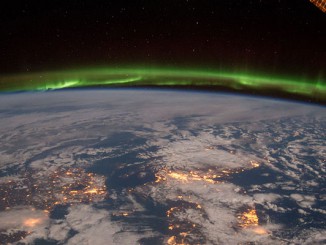
An engineering and scientific marvel of our age, construction of the ISS began with the launch of the first module, Zarya, in November 1998. Since then, more than 115 constructional space flights using five different types of launch vehicles have led to the 73 x 109 x 20 metre, 420-tonne structure that we see today. The orbital outpost has been continuously occupied since November 2000 and has seen more than 200 visitors from 15 countries.
Using Astronomy Now’s Almanac to make ISS viewing predictions
Many of you may have used our online Almanac to obtain information about lunar phases, or the rising and setting of the Sun, Moon and planets for wherever you may live, but the Almanac can also tell you when and where to see the International Space Station.
In the Almanac, select the closest city to your location from the Country and City pull-down menus before ensuring that the box beside Add ISS passes? has a tick in it and — just as importantly — the Daylight Savings Time? box, if applicable to your time and location. The table underneath the month’s Moon phase data then shows current nighttime passes of the International Space Station over your chosen location during the next five days, if any.
Here is an example computed for Edinburgh: For the given Date in year/month/day format, Local Time is the instant the ISS first becomes visible and Duration indicates the length of the sighting in minutes. At the given Local Time, look in the direction indicated by Approach and, weather permitting, you should see the ISS as a slowly moving, bright “star”. Max. elevation is how high the Station will get above your horizon (90° is overhead, while 20° is about the span of an outstretched hand at arm’s length) and Departure indicates where the ISS will be when it vanishes from sight. Sometimes an appearance or disappearance occurs well up in the sky when the Station emerges into sunlight or slips into Earth’s shadow, respectively.
For the given Date in year/month/day format, Local Time is the instant the ISS first becomes visible and Duration indicates the length of the sighting in minutes. At the given Local Time, look in the direction indicated by Approach and, weather permitting, you should see the ISS as a slowly moving, bright “star”. Max. elevation is how high the Station will get above your horizon (90° is overhead, while 20° is about the span of an outstretched hand at arm’s length) and Departure indicates where the ISS will be when it vanishes from sight. Sometimes an appearance or disappearance occurs well up in the sky when the Station emerges into sunlight or slips into Earth’s shadow, respectively.
In the example above, as seen from the Scottish capital on the evening of 2 August, the ISS first appears 14 degrees (a span and a half of a fist at arm’s length) above the southwest (SW) horizon at 11:17pm BST in a viewing window lasting four minutes. It attains a peak altitude of 30 degrees above the southern (S) horizon before fading into the Earth’s shadow 21 degrees above the east-southeast (ESE) horizon at 11:21pm BST.
Note: the actual times of events in the future will change as the true orbit of the ISS varies over time; predictions made on the day are more accurate.
If you need assistance visualising how the ISS moves through the sky, perhaps this fictitious example will help:
Given the International Space Station’s physical size, proximity, and brightness (at its best it can rival Venus), one might suppose that it would be fine object to see through a telescope. Indeed, when passing overhead at a favourable orientation, it can exceed an arcminute in angular size — about the same as Venus close to inferior conjunction.

Observers with computerised mounts that can be driven by external software designed to track satellites a have much greater chance of success. Astrophotographers Thierry Legault and Ralf Vandebergh have succeeded in capturing stunning pictures of the ISS showing fine structural detail that are an inspiration to imagers the world over.
As I said at the beginning of the piece, the beauty of the International Space Station sailing silently overhead needs nothing more than the naked eye to appreciate. Furthermore, if you do make a sighting, contemplate the six-person crew of Expedition 44 that are currently aboard. Clear skies!
Inside the magazine
You can find out more about observing in the August edition of Astronomy Now in addition to a full guide to the night sky.
Never miss an issue by subscribing to the UK’s biggest astronomy magazine. Also available for iPad/iPhone and Android devices.




